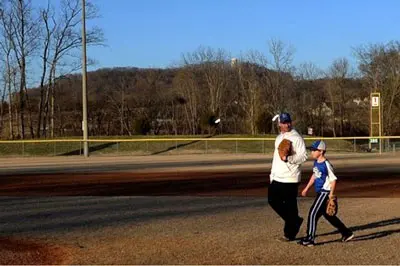
Dec 07, 2017 • 4 min read
Pressure in Youth Sports: Protect Kids or Teach Them to Deal With It?
Posted in:
“C’mon, Mason, you can do it! One more strike, put him in the books!”
As these encouraging words resonate from the crowd, Mason receives the ball back from the catcher after throwing one in the dirt, allowing the runner to score from third–one ball, two strikes. He pauses to compose himself, taking a breath to relax his mind and loosen the muscles. He hears the crowd but they become mere background noise as he prepares to allow his body to act without his mind doing anything. The pitch is on the way–strike three!
 Does it seem unrealistic for a 9-year-old kid to have this kind of mental control over his thoughts in the heat of competition? Along with proper mechanics, my student Mason has been taught a routine that helps him mentally prepare before every pitch. This routine keeps his mind “in the moment” instead of “in the crowd.”
Does it seem unrealistic for a 9-year-old kid to have this kind of mental control over his thoughts in the heat of competition? Along with proper mechanics, my student Mason has been taught a routine that helps him mentally prepare before every pitch. This routine keeps his mind “in the moment” instead of “in the crowd.”
You won’t see this kind of poise from a kid with little or no training. After throwing a wild pitch, you are more likely to see negative body language–looking into the crowd at his parents or rushing the next pitch hoping to get lucky. The truth is, in a competitive environment a trained pitcher merely feels challenged while an untrained pitcher feels pressured.
In youth sports, preparation equals fun.
Whatever the sport, teaching kids about basic mental preparation is crucial for managing pressure. It starts with taking a breath. Doing this consistently will focus the mind and loosen the muscles, allowing the body to effortlessly perform the mechanics unique to the sport. If taught along with basic physical technique, kids will learn it. It’s that simple.
The best time to learn how to manage pressure is when an athlete is young; the best time to teach it is at practice. When failure happens, be ready to give instruction.
What causes pressure? Along with a lack of training, unrealistic expectations from parents and coaches are a big cause. If these expectations are out of balance with the amount of training a young athlete has, there will be pressure, and it can be overwhelming.
 As parents, we purposely train our kids to listen to our voices at all times. Usually, this is a good thing, but it’s not particularly helpful when your child is trying to perform a difficult skill like hitting or pitching a baseball, so coaching from the stands should be avoided. Encouraging cheers from the crowd can also be distracting for some kids.
As parents, we purposely train our kids to listen to our voices at all times. Usually, this is a good thing, but it’s not particularly helpful when your child is trying to perform a difficult skill like hitting or pitching a baseball, so coaching from the stands should be avoided. Encouraging cheers from the crowd can also be distracting for some kids.
Cheering is a normal part of a competitive event; this will never change, nor should it have to. How a kid responds to the cheering, however, should be cause for reflection for parents. If a player feels pressure from normal cheering and failing because of it, it may mean that their parent’s expectations have been unrealistic the whole time, not just during today’s game. Just hearing their parent’s voice can rattle even the most talented kid if they’ve been constantly over-coached on results, and this is the problem, not the cheering. Instead of “C’mon, you can do it,” this player sub-consciously hears, “C’mon, you better do it!” Parent’s expectations are powerful! If they are unreasonably high, they can shatter confidence and ruin a young player’s competitive experience.
The key is to not add unnecessary pressure by over-coaching during competition. Once the game starts, an athlete’s training is what they can count on, not some anxiety-ridden parent or coach yelling, “Throw strikes!”
Pressures in professional sports and youth sports are similar, but when it comes to managing this pressure, the age and experience levels of the athletes makes the difference. Pressure is normal during competition, but an athlete needs to learn effective ways to cope with it or the pressure is likely to win the battle.
Chuck Schumacher is the author of “How to Play Baseball: A Parents Role in Their Child’s Journey,” available at www.chuckschumacher.com (signed copy) or Amazon. Chuck has 20 years experience as a youth baseball coach and 40 years experience in martial arts. In 2006, he opened Chuck’s Gym in Franklin, Tenn., where he teaches baseball and Okinawan karate. You can contact Chuck at chucksgym@comcast.net.
